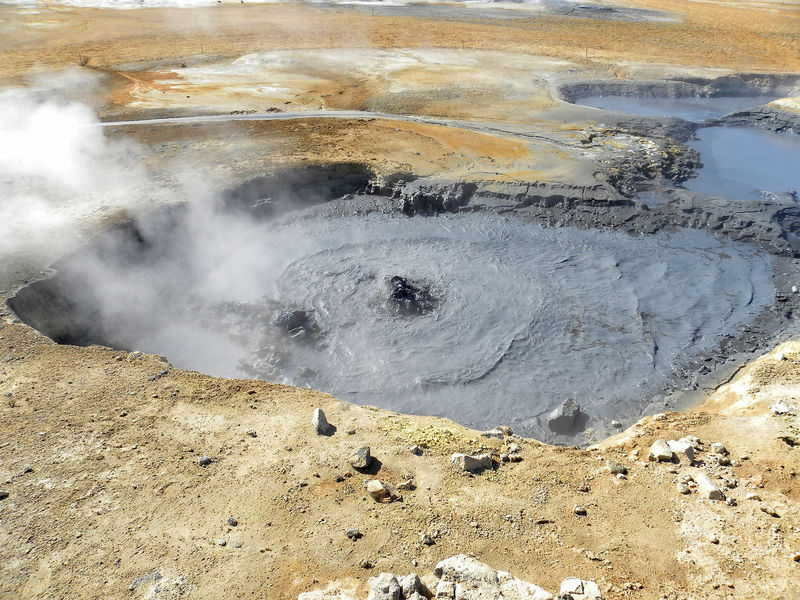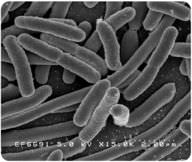19.1简单细胞的进化
章节大纲
-
What would you see if you could go back 4.5 billion years?
::如果你能追溯到45亿年前 你会看到什么?If you took a field trip back in time to the earliest Earth, things would be very different. Everything would be very hot. What company would you have? Maybe some simple microbes. Maybe not.
::如果你一次实地考察 回到最早的地球, 情况会非常不同。 一切都会非常热。你会有哪个公司?也许有些简单的微生物。也许不是。Ancient Life
::古代人For the first 4 billion years of Earth history there is only a little evidence of life. Organisms were tiny and soft and did not fossilize well. But scientists use a variety of ways to figure out what this early life was like. Note that the period from Earth's origin to the beginning of the Phanerozoic is called the Precambrian.
::在地球历史的最初40亿年中,只有一点生命的证据。生物体是微小的,柔软的,没有化石化的。但科学家们用多种方法来弄清楚早期生命是什么样子。请注意,从地球起源到Phanerozoic的开始,这段时期被称为Precambrian。Life Begins
::生命开始Life probably began in the oceans. No one knows exactly how or when. Life may have originated more than once. If life began before the Moon formed, that impact would have wiped it out. Then life would have had to originate again. Eventually conditions on Earth became less violent. The planet could support life.
::生命可能起源于海洋。没有人确切地知道生命是如何或何时开始的。生命可能起源于不止一次。如果生命起源于月球形成之前,那么这种影响就会消灭它。然后生命必须再次起源。最终,地球上的条件变得不那么暴力。地球可以支持生命。The first organisms were made of only one cell ( Figure ). The earliest cells were prokaryotes . Prokaryotic cells are surrounded by a cell membrane. They do not have a nucleus . Their organelles are free in the cell. The cells get their nutrients directly from the water they live in. The cells need to use these nutrients to live and grow.
::第一个生物体只有一个细胞(图 ) 。 最早的细胞是prokaryotes 。 Prokaryote 细胞被一个细胞膜包围, 它们没有核。 细胞中的有机体是免费的。 细胞的营养素直接来自它们居住的水中。 细胞需要使用这些营养元素来生存和生长。E. coli (Escherichia coli) is a primitive prokaryote that may resemble the earliest cells.
::E. coli (Escherichia coli) 是一种原始的原细胞,可能类似于最早的细胞。The cells also needed to be able to make copies of themselves. To do this they stored genetic information in nucleic acids . The two nucleic acids are DNA (deoxyribonucleic acid) and RNA (ribonucleic acid). Nucleic acids pass genetic instructions to the next generation.
::细胞也需要自己复制。 为了做到这一点,细胞将遗传信息储存在核酸中。两种核酸是DNA(脱氧核糖核酸)和RNA(核糖核酸),核酸将基因指示传给下一代。Oxygen Enters the Atmosphere
::氧气进入大气Early cells took nutrients from the water. Eventually the nutrients would have become less abundant.
::早期细胞吸收了水中的养分 最终养分会变得不那么丰富Around 3 billion years ago, photosynthesis began. Organisms could make their own food from sunlight and inorganic molecules. From these ingredients they made chemical energy that they used. Oxygen is a waste product of photosynthesis. That first oxygen combined with iron to create iron oxide . As more oxygen was produced, the gas entered the atmosphere .
::大约30亿年前,光合作用开始。 生物可以用阳光和无机分子做自己的食物。 它们用这些成分制造化学能量。 氧是光合作用产生的废物。 首先是氧和铁结合产生氧化铁。 随着更多的氧的产生,气体进入大气。Some of the oxygen in the atmosphere became ozone . The ozone layer formed to protect Earth from harmful ultraviolet radiation . This made the environment able to support more complex life forms.
::大气层中的一些氧气成为臭氧,臭氧层形成的目的是保护地球免受有害的紫外线辐射,使环境能够支持更复杂的生命形式。Early Organisms
::早期生物The first organisms to photosynthesize were cyanobacteria . These organisms may have been around as far back as 3.5 billion years. Cyanobacteria are still alive today ( Figure ). Now they are called blue-green algae. They are common in lakes and seas, and they account for 20% to 30% of photosynthesis today.
::光合作用的第一个生物体是氰化细菌。这些生物体可能早在35亿年前就存在了。现在,这些生物体被称为蓝绿藻,在湖泊和海洋中很常见,占光合作用总量的20%到30%。These rocks in Glacier National Park, Montana may contain some of the oldest fossil microbes on Earth.
::蒙大拿州冰川国家公园的这些岩石 可能含有地球上最古老的化石微生物Summary
::摘要- A prokaryote has a cell membrane but otherwise organelles are loose within the cell.
::白喉有细胞膜,否则器官在细胞内会松散。
- Photosynthesis allows organisms to produce food energy with oxygen as a by-product. After photosynthesis evolved, iron oxidized and then oxygen entered the atmosphere. Ozone was created in the upper atmosphere.
::光合作用使生物体能够以氧作为副产品产生食物能量,在光合作用进化后,铁氧化后进入大气,臭氧在上层大气中产生。
- Cyanobacteria, which are still around today, were the earliest known photosynthesizing organisms.
::今天仍然在周围的氰化细菌是最早已知的光合成生物。
Review
::回顾- Describe the features of prokaryotes.
::描述prokaryotes的特征。
- Why was the development of photosynthesis so important to the evolution of life?
::为什么光合作用的发展 对生命的进化如此重要?
- What do we know about the first life forms?
::我们对第一生命形式了解多少?
Explore More
::探索更多Use the resource below to answer the questions that follow.
::利用以下资源回答以下问题。- What are cyanobacteria?
::什么是蓝细菌?
- When did cyanobacteria dominate Earth?
::蓝细菌何时主宰地球?
- How are the features of a prokaryotic cell?
::蛋白质细胞的特征如何?
- What are cyanobacteria responsible for?
::氰化物对什么负责?
- Where are cyanobacteria found?
::哪里发现蓝菌?
- What are stromatolites?
::什么是电磁石?
- How do we know that stromatolites flourished early in Earth history?
::我们怎么知道在地球历史早期 斯托马托利石的繁荣?
- What is a heterocyst? What does it do?
::什么是异体细胞?
- What is an akinete? What is its function?
::什么是外形?它的功能是什么?
- A prokaryote has a cell membrane but otherwise organelles are loose within the cell.


